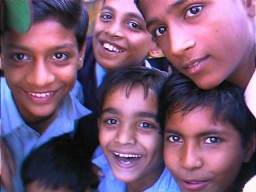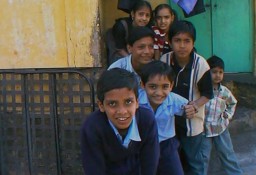|
All images and text are copyright protected. Contact
|
 I leave Bombay at night. We stop at several dhabas where I eat samosas, channa and drink hot sweet tea. The night grows chilly and the family beside me on the bus share out woolen shawls the size of blankets. In the morning, the girl turns to ask me in an Australian accent about my country. Her family left India when she was five to live in Africa and after seven years they went to live in Australia where she is studying Information Technology. "The guide books and the media persist in giving false impressions about India," she says wryly. "They still write about suttee and never eating with your left hand and other misconceptions. They think it's romantic." Did she speak Hindi or other Indian languages? "Only a little and pretty badly too, but I come back here to my family every few years and they accept me as being Indian." The land, not noticeable in the city, becomes brown and the grass is dry. Cows, buffalo and people roam the countryside looking for greener pastures. Against this arid land-scape, women in red, yellow, pink saris walk in single file carrying clay pots on their heads. Just before midday we arrive in Amedabad, the capital of Gujarat State. Sometime in the last two hours of the bus journey I break out in a rash that quickly worsens and covers my whole body with an intolerable itch. 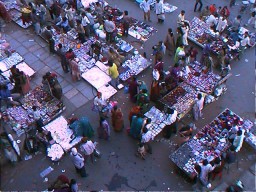 I am also still nursing a cough from winter in Istanbul and a mild diarrhea from Bombay so I
find a small hotel in the Old City and spend the next few days lathering moisturising cream on my skin, reading John Grisham and watching cable TV. In a couple days the rash has developed into large bumps and I progress to a course of antibiotics in addition to the cream. I persuade myself that drinking a lassi yoghurt every day will cure the plague that is overtaking me and also drink coconut water to rehydrate myself from the debilitating diarrhea. In bouts of restlessness I venture outside and eat a fruit salad from an open street stall or an ice cream from the shop next door. I discover that with a little effort an illness need not be a miserable affair.
I am also still nursing a cough from winter in Istanbul and a mild diarrhea from Bombay so I
find a small hotel in the Old City and spend the next few days lathering moisturising cream on my skin, reading John Grisham and watching cable TV. In a couple days the rash has developed into large bumps and I progress to a course of antibiotics in addition to the cream. I persuade myself that drinking a lassi yoghurt every day will cure the plague that is overtaking me and also drink coconut water to rehydrate myself from the debilitating diarrhea. In bouts of restlessness I venture outside and eat a fruit salad from an open street stall or an ice cream from the shop next door. I discover that with a little effort an illness need not be a miserable affair.I chat with the manager of the 500 year old Badra Fort who allows me to climb the dizzying steps to the walled turrets. At the top I can see the concentric circles of the stairway and the vertigo-inducing narrow walls atop which the warriors would need to balance while fighting. The manager picks up a stray kite left over from Makara Sankranthi, Ahmedabad's world famous Kite Festival, held during the previous week. He tosses it over the edge where it sails down to the Badra Market below. Like industrious ants, vendors and buyers scurry about in the market bright with fruit and glittering things. I see several children flying kites but cannot find a single kite shop. They tell me that the festival is over, the shops closed and the kids make their own kites. 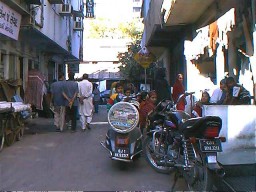 An auto-rickshaw takes me to the Gandhi Ashram in the north dusty industrial section of town.
Mahatma Gandhi formed the Ashram on the shores of the Sabarmati River and lived here from 1917 to 1930. It is from here that he began the historic satyagrahas to defy British imperialism and to eventually evict them in 1947. The ashram is airy, spacious and calm. Much of it has been renovated into a museum and library while the historical bungalows have been preserved. Beside the few visitors sprawled in groups on the grass there is not much activity. There are orphan children living and studying in quarters at the back and a few visiting students from nearby colleges who chat briefly with me. An auto-rickshaw takes me to the Gandhi Ashram in the north dusty industrial section of town.
Mahatma Gandhi formed the Ashram on the shores of the Sabarmati River and lived here from 1917 to 1930. It is from here that he began the historic satyagrahas to defy British imperialism and to eventually evict them in 1947. The ashram is airy, spacious and calm. Much of it has been renovated into a museum and library while the historical bungalows have been preserved. Beside the few visitors sprawled in groups on the grass there is not much activity. There are orphan children living and studying in quarters at the back and a few visiting students from nearby colleges who chat briefly with me.On the other hand, Gandhi Road in the Old City, made almost impassable by a continuous line of street stalls and scooters, is a hubbub of activity. I walk the length of it every day to eat shalijani pulav or bundi raita at the vegetarian Sanman Restaurant. The manager, Mr Kaka Delhivala, is a kindly soft-spoken gentleman who suggests places and good inexpensive hotels in India he thinks might be of interest to me. I am still in bed at eight forty-five on the morning of India's Republic Day when the room shakes. The ceiling fan sways and creaks. A sudden hush blots out the background noise. Small muffled screams come from the neighbouring rooms and there is a rush to the ground floor and outside. 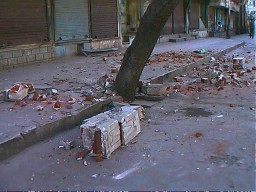 I stand in the doorway of my room and wait. After the tremors subside I go downstairs where the guests and hotel staff mill about talking nervously. They are frightened but unhurt. Outside in the street, the neighbours talk excitedly and examine the stones and shingles fallen from the buildings. It is Republic Day and a holiday for most businesses and so the streets are quiet. The few people on Gandhi Road are also examining the damaged buildings. One crenel of the city gate has fallen to the ground and shattered but the Old City is relatively unharmed. I walk to the Sanman Restaurant which is being cleaned and ask after my friend Mr Delhivala and his family. Since the restaurant is not open for business he is not at work today but they believe he is safe. Back at the hotel, the staff are all outside the front doors. In the lobby the first newscasts are showing collapsed buildings in the New City and the survivors digging for victims. There are interviews with the Indian ambassador in London asking him about disaster relief programmes and international aid. He waffles about India being self-reliant and hedges on accepting foreign aid. CNN, the American news channel, and BBC World are relaying telephone reports from Ahmedabad and Bhuj through Delhi. The first reports on fatalities quote the seismic shock at 6.9 on the Richter scale and 45 to 100 dead. Later, they would revise the figures to 7.9 on the Richter scale and the death toll from 650 to 1000 people. The final figures would reach one lakh or 100,000 deaths. I am tempted to take a rickshaw to the affected areas but I am untrained in disaster relief and unable to help in any way. I would only be in the way and probably do more harm than good.
I chat with the neighbours and their children. They are getting over their fright and returning to normal. Businesses are open and people going about their everyday routine as far as they can. It feels as if the disaster has happened in another city. I point out to the hotel staff that people in the new part of town are trapped in the collapsed buildings. They nod and shrug, what can we do? The telephone lines are down and I am unable to e-mail my friends and family that I am safe. The following day the number of deaths is estimated in the region of 5000 people. Foreign journalists have been flown in to the affected areas of Gujarat: the epicentre in Bhuj and Ahmedabad and are analysing the earthquake clinically and critically. They would eventually total 5000 'relief workers' who would "drain the disaster economy here of precious supplies as they 'visited' wrecked sites clicking pictures." The Hindustan Times called them "earthquake tourists" who "took advantage of the free transport, cornered relief material, drank only mineral water and had free meals at the community kitchens that had been set up." When they left one month later, India breathed a sigh of relief. Apart from some tension the Old City returns to normal. Mr Delhivala and his family are well and unaffected by the quake. Sanman Restaurant is open as usual. I ask him for an organisation where I may donate money and he gives me a telephone number for the Red Cross. I say my goodbyes and he gives me a couple keepsakes as we part. I am leaving from fear of dysentery and cholera that sometimes accompany widespread disasters due to the disruption of waterlines and power supplies and the overburdened systems for taking care of the injured and dead. In the New City, rescue workers continue to reach victims trapped under debris. The TV news warn of after shocks. On Saturday night I sleep in my clothes with my luggage packed for an emergency departure. On Sunday morning at eight, there is another quake. Guests call urgently to one another and hurry downstairs. By the time I get to the lobby, everyone is already there fully dressed, with shawls to ward off the cold morning chill. I call the Red Cross but the person answering does not speak English. My hotel staff translates to say that there is no system in place for receiving funds. All the guests are leaving and the hotel manager is unhappy. At 10 o'clock my bus leaves Ahmedabad for Udaipur in Rajasthan. The Gujarati passengers pray to Mother mata for a safe journey: "mata mata ki!" And the other passengers respond: "Jai!" Raceandhistory.com | Howcomyoucom.com | Trinicenter.com | TriniView.com Another 100% non-profit Website serving poorly represented communities. Copyright & Disclaimer. - - Privacy Policy --Designed & maintained by S.E.L.F. © 2002 TriniView.com |

